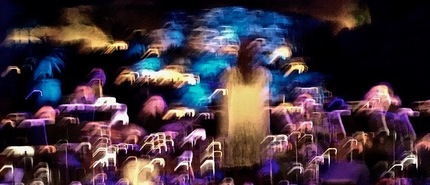Lauren Baba said she was glad that, since her back would be turned toward us, we couldn't see the funny faces she makes when she conducts her Baba Orchestra. The 17 musicians weren't laughing, though; they were flowing, blending, and hitting the transitions of her complex new long-form composition, "Marigold."
Inspired by the story of Baba's Syrian immigrant forebears, "Marigold" met the conditions of the L.A. Jazz Society's New Note program, which has been commissioning works that reflect the feel and culture of Los Angeles. (Gurrisonic Orchestra's "Street Signs," performed here at the Angel City Fest two years ago, marked another example.) The suite began with a quiet awakening, an awareness of possibilities. Ellingtonian saxes oozed and gathered energy into a collective roil reflecting disparity and conflict. Low-end riffs emerged and drove with consolidated power, then the rhythm, although persisting, settled into loops of stasis. With peace established, the eyes that had blinked open at dawn blinked closed into unsettled dreams.
Drawing from elements of classical, jazz and Arabic music, Baba had wordlessly unspooled the chapters of a subtly overlapping history. Although her composition eschewed the melodies of Ellington's "Black, Brown and Beige," the passion of Mingus' "Epitaph" or the apocalyptic vision of Ornette's "Skies of America," it rang with her own fine sense of detail, unconventional harmonic sensibility and command of rhythmic techniques, conveying both inspiration and control. The players contributed formidable individuality: Cathlene Pineda's piano acting as the composer's left arm to communicate considered intelligence, Gavin Templeton's sax injecting fevered energy, Tina Raymond's rock-rollin' drums providing a reliable north star for the ensemble's meter and accents. Satisfying. The crowd dug it.
Xenia Rubinos transported us to a whole different region of American assimilation. Of Cuban and Puerto Rican parentage, the Brooklyn singer was not about to omit any influence that ever kicked her ass, and the result, breathing the spirit of jazz if not any identifiable tradition, made for an original and thrilling expression.
From behind keyboards to behind a bass to solo center stage, Rubinos' shock-wave vocals fixated every second of our attention as her shadow danced against the old Shakespearean tower wall. Her big range and deep feeling would have struck hard enough, but when she flung back her curly pile of hair and cut loose one of those high sustains, she just about crumbled the entire open-air edifice, Samson-style. Rapping and torching, scatting and selling the soul, the wiry diva strutted in her styly black dress with a confidence that might have seemed arrogant if a certain vulnerability didn't lurk beneath. Plenty of credit went to her bare-bones band: deadpan bassist Jackson A. Hill and low-slung drummer Marco Buccelli laid down 20 kinds of groove with dropforged authority, and also managed to complement Rubinos' creative use of self-harmonizing electronic loops (a live technique pioneered here in the '90s by Kaoru Mansour) with appealingly weird synthesized noise trash.
In the audience, heads from elder gray to teen blond banged in unison. Yeah.

* * *
PHOTOS BY FUZZY BURGOZA.

